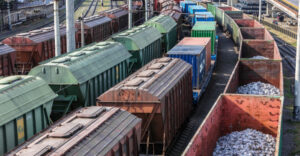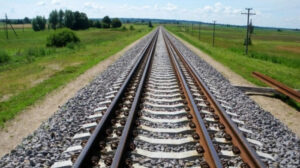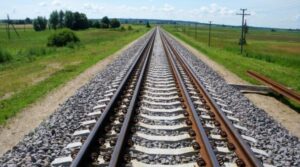
The volume of freight traffic carried by Ukrzaliznytsia in 2025 will decrease by 7% compared to last year, from 173 million tons to 160 million tons, and in subsequent years it will only be possible to increase it to 161 million tons and 162 million tons, respectively, the company announced to journalists during a presentation on November 7.
According to the presentation, it is expected that in 2025-2026, the volume of ore and manganese transportation will amount to 44 million tons compared to 43 million tons last year, and in 2027, it will decrease to 42 million tons.
Grain and flour transportation in 2025-2027 is forecast at 31 million tons, which is 22.5% or 9 million tons less than in 2024.
Ukrzaliznytsia noted that it expects a reduction in the transportation of building materials from 35 million tons in 2024 to 30-32 million tons in 2025-2027.
According to the presentation, coal transportation volumes in 2025-2027 will decrease by 17.4% compared to 2024, from 23 million tons to 19 million tons.
The company plans to partially offset these losses by increasing the transportation of other cargo from 32 million tons last year to 36 million tons this year, and then increasing it by 1 million tons annually.
Ukrzaliznytsia added that the total volume of cargo transportation from 2021 to 2025 decreased by 49% – from 315 million tons to 160 million tons. In particular, during this period, there was a 43% reduction in ore transportation, 52% in building materials, and 62% in coal.
According to the presentation, the forecast for the profitability of freight transportation is even worse: last year’s profit of UAH 20.4 billion will decrease to UAH 3.2 billion next year, and the following year, freight transportation will bring a loss of UAH 0.6 billion, and in 2027 – UAH 4.8 billion.
The company cites the freezing of tariffs, which were last increased in 2022, as the reason, although the producer price index has risen by 69.3% since then.
In September 2025, Valery Tkachov, deputy director of the commercial department of Ukrzaliznytsia, reported that the company expects freight traffic to decline this year to 162-165 million tons from 175 million tons last year, after partially recovering from a drop to 150-155 million tons in the first two years of Russia’s full-scale aggression from 312-315 million tons.
Tkachov then stressed that in order to rectify the situation, an active search for new cargoes is underway, in particular, retail and small and medium-sized business cargoes, ranging from forest products to industrial products and a large number of other segments.
Serhiy Leshchenko, deputy chairman of the supervisory board of Ukrzaliznytsia, reported last week in the Verkhovna Rada that the company’s net loss for the first nine months of this year amounted to UAH 7.195 billion.
According to him, the company proposes to index freight tariffs by 27.5% from January 1 next year and by another 11% from July 1.
The volume of Ukrzaliznytsia’s export shipments in January-June 2025 decreased by 13.5% to 38.7 million tons, domestic shipments by 11.7% to 35.5 million tons, while the volume of import transportation increased by 5.4% to 5.3 million tons.
In 2024, the company increased its revenue by 11.1% to UAH 102.87 billion, but incurred a net loss of UAH 2.71 billion compared to a net profit of UAH 5.04 billion in 2023.

“To ensure sustainable operations in 2026, Ukrzaliznytsia (UZ) must cover a liquidity deficit of around UAH 48.8 billion, excluding the repayment of Eurobonds, whose debt is to be restructured,” said CEO Oleksandr Pertsovsky on Friday during a presentation on passenger transport financing and the model for launching the UZ-3000 program.
“We have chosen the most balanced model to cover this deficit: part of it will be provided by our internal optimization, part by tariff decisions, and the third part by state support for passenger transport. There are no other realistic ways to get through these years in the context of the war,” he emphasized.
According to him, the amount of state co-financing for passenger transport will amount to up to UAH 13 billion in 2025 and will increase to more than UAH 16 billion in 2026.
According to Pertsovsky, operating losses in passenger transport total UAH 24 billion per year (UAH 13 billion for long-distance transport and UAH 11 billion for local transport), and while it was previously possible to offset these losses at the expense of profits in freight transport, this is impossible during the war.
According to the presentation, the expected loss in the passenger transport segment will increase from UAH 18.1 billion last year to UAH 18.6 billion this year, UAH 21.9 billion next year, and UAH 24.4 billion in 2027.
Suburban transport is expected to lose UAH 10.9 billion next year, domestic transport UAH 13.4 billion, and only international passenger transport will be profitable, with UAH 2.4 billion.
At the same time, UZ forecasts that profits from freight transport will decline from UAH 20.4 billion last year to UAH 3.2 billion this year, with a loss of UAH 0.6 billion next year, increasing to UAH 4.8 billion in 2027.
The reasons for this change in the profitability of freight transport are a reduction in volume (coal – by 4 million tons, grain – by 9 million tons after the artificial peak in 2024) and a reduction in transport distances, resulting in a loss of UAH 14.5 billion in freight revenue, as well as rising costs (personnel, electricity, financial costs) with frozen tariffs, which means an additional UAH 2.7 billion in expenses.
According to the presentation, the projected net loss for next year is UAH 28.64 billion.
In addition, the company expects UAH 25.4 billion in critical restructuring costs with depreciation of UAH 15.9 billion, UAH 6.4 billion in interest payments on Eurobonds, and UAH 4.2 billion in repayments of EBRD and EIB loans, which together result in a liquidity deficit of UAH 48 billion, according to the presentation.
As part of its own optimization, UZ has proposed an economic effect of almost UAH 17 billion in 2026, of which UAH 6.7 billion has already been taken into account in the draft financial plan. A further UAH 10.2 billion is to be achieved by reducing administrative costs, transferring non-core assets, cooperating with the freight market, and increasing its own revenues.
According to the presentation, the optimization measures include the elimination of 69 of the most unprofitable suburban routes (up to 5,000 per day), the indexation of unregulated elements (commissions, services), and flexible dynamic pricing for individual segments, which are expected to generate a total of UAH 6.9 billion.
In addition, there are plans to optimize the workforce by 8,300 employees, merge regional railways, and optimize up to 1,200 km (less than 5%) of the network with no or minimal traffic (1-2 suburban pairs).
Energy efficiency measures also include operating during intervals with the lowest fares, doubling rental income (+UAH 100 million), the sale of surplus and non-core assets, the sale of scrap metal (over 370,000 tons, which is more than UZ has sold in the last 5 years and secures the company a 28% share of the scrap market), and reducing repairs to passenger cars, regional trains, and infrastructure.
Ukrzaliznytsia points out that the financing model for passenger transport is in line with the European practice of public service obligation (PSO), whereby the state covers the difference between economically justified costs and tariffs.
Earlier this week, Serhiy Leshchenko, deputy chairman of the UZ supervisory board, told the Verkhovna Rada that the company’s net loss for the first nine months of this year amounted to UAH 7.195 billion.
According to him, UZ proposes to index freight tariffs by 27.5% from January 1 next year and by another 11% from July 1.
In January-June 2025, UZ’s export traffic decreased by 13.5% to 38.7 million tons, domestic traffic decreased by 11.7% to 35.5 million tons, while import traffic increased by 5.4% to 5.3 million tons.
Passenger traffic increased by 1.2% to 13.52 million in the first half of 2025.
In 2024, UZ increased its revenue by 11.1% to UAH 102.87 billion, but reported a net loss of UAH 2.71 billion, compared to a net profit of UAH 5.04 billion in 2023.

Ukrzaliznytsia (UZ) plans to raise ticket prices for SV and first class Intercity to partially compensate for losses from passenger transportation, said Serhiy Leshchenko, deputy chairman of the UZ supervisory board.
“We plan to raise dynamic pricing for SV and first class Intercity. This will partially improve the results, but not completely,” he said from the rostrum of the Verkhovna Rada, where he was summoned by deputies the day before, according to a correspondent from the Interfax-Ukraine agency.
Leshchenko noted that in order to avoid losses from passenger transportation altogether, it is necessary to increase passenger transportation prices by 3-4 times, which is impossible during the war.
The last time Ukrzaliznytsia raised prices was on February 1 this year for international trains to Poland and Hungary – by 17-37%. Thus, due to a reduction in discounts, the cost of tickets to Poland increased by 20-27% in 1st class “Intercity+” and SV carriages and by 9-27% in compartment carriages. The cost of travel on the most popular international trains: Kyiv-Warsaw increased by 37%, Kyiv-Budapest by 17% in SV carriages and by 21% in compartment carriages.
According to Ukrzaliznytsia’s expectations, which were presented in the 2026 state budget draft, losses from passenger transportation in 2025 will amount to UAH 20.8 billion, in 2026 – UAH 22.3 billion, in 2027 – UAH 24.7 billion, and in 2028 – UAH 29.4 billion.
According to the company’s results for 2024, losses in the passenger transport segment increased by UAH 2.4 billion, or 15.4%, to UAH 18.1 billion, which was covered by profits from the freight transport segment, which amounted to UAH 20.4 billion. At the same time, the company forecasts a sharp decline in freight transportation profits in 2025 to UAH 0.9 billion, moderate growth in 2026 to UAH 9.0 billion, in 2027 to UAH 12.6 billion, and in 2028 to UAH 19.3 billion.
Overall, in 2024, UZ increased its revenue by 11.1% to UAH 102.87 billion, but incurred a net loss of UAH 2.71 billion compared to a net profit of UAH 5.04 billion in 2023.

Based on the results of 2025, JSC Ukrzaliznytsia expects international passenger traffic to grow by 11% compared to 2024 – to 3 million passengers from 2.7 million, said Oleg Golovashchenko, director of the Passenger Company branch Oleg Golovashchenko, director of the Passenger Company branch of JSC Ukrzaliznytsia, at the VII International Conference “Production, Operation, and Repair of Rolling Stock” on Thursday.
According to his data, 1.8 million passengers were transported in January-September 2025. In pre-war 2021, the figure for international passenger traffic was 147,000, and in 2023, it was 2.3 million passengers.
As previously reported, Ukrzaliznytsia launched a daily train on the Kyiv-Bucharest route on October 10. In September 2025, the first section of the European gauge railway between Chop and Uzhhorod was opened in Zakarpattia.
At that time, the chairman of the board of JSC Ukrzaliznytsia, Oleksandr Pertsovskyi, noted that this project is an important stage in the development of the European railway network in Ukraine. According to him, in 2026, it is planned to electrify this section and start the construction of a European gauge railway in the direction of Lviv, which should be completed within two to three years.
In addition, during the Kyiv International Economic Forum (KIEF) in mid-October, Oleg Yakovenko, director of the strategy and transformation department of Ukrzaliznytsia, announced that the company, with European and state co-financing, plans to implement the Mostytska-Sknyliv project in the next two years and further develop the Lviv-Uzhhorod-Chop and Lviv-Chernivtsi-Vadul-Siret (Romania) corridors, which will allow Ukraine to begin restoring and realizing its unique geographical status.
Overall, the monopoly railway operator JSC Ukrzaliznytsia increased passenger traffic by 1.2% in the first half of 2025, to 13.52 million, which is 23% more than in January-June 2024.

Ukrzaliznytsia (UZ), subject to European and state co-financing, plans to implement the Mostytska-Sknyliv project in the next two years and further develop the Lviv-Uzhhorod -Chop and Lviv-Chernivtsi-Vadul-Siret (Romania), which will allow Ukraine to begin restoring and realizing its unique geographical status, said Oleg Yakovenko, director of the strategy and transformation department at Ukrzaliznytsia.
“We also plan to obtain grant funds for the Mostyska-Sknyliv project, which will connect 80 km of European gauge track between the Polish border and Lviv. Next, we are currently conducting technical and economic studies on the corridors connecting Lviv, Chernivtsi, and Romania,” Yakovenko said during the Kyiv International Economic Forum (KIEF) on Thursday, October 16.
According to him, as part of Ukraine’s integration into the European Union, UZ plans to develop 1435 mm gauge railways and European transport corridors on the territory of Ukraine. The European integration reform of the railway industry also envisages a radical change in the functioning of the entire railway model in Ukraine.
“First of all, we are talking about market reform, which involves separating the infrastructure operator within Ukrzaliznytsia from the transport operators. This will allow us to liberalize the market in the future. It will also allow us to create market mechanisms specifically for transport,” Yakovenko explained.
He named the introduction of European rules on technical compatibility and interoperability as another element of the reform. This concerns technical safety standards, as well as changes to the safety management system.
The director of the strategy and transformation department at Ukrzaliznytsia noted that a draft law “On the safety and interoperability of Ukraine’s rail transport” is currently planned to be submitted for adoption by the end of the year, while next year the company expects a law on market liberalization to be introduced.
As Yakovenko explained, it is expected that a so-called infrastructure access tariff will be formed, according to which market participants will be able to purchase certain access to transport routes from the infrastructure operator on a competitive basis.
“These tariffs will be regulated, i.e., they will be formed in accordance with the tariff formation procedure and will reflect economically justified tariffs in accordance with European rules,” emphasized the representative of Ukrzaliznytsia.
It is noted that the new system will introduce separate PSO (Public Service Obligation) contracts between passenger carriers and the state at the national level, as well as between carriers and local authorities. This should remove the financial burden from freight transport.
As reported, in September, a section of standard (“European”) 1435 mm gauge railway was opened between Uzhhorod and Chop in Zakarpattia Oblast, which will allow for direct rail connections between Uzhhorod and a number of European capitals.
In addition, in January 2025, it was reported that the reconstruction of the railway track on the section “Polish State Border – Mostyska II – Sknyliv (Lviv)” would be postponed until 2026, although in February 2024, the then Deputy Prime Minister for Recovery – Minister of Community, Territory and Infrastructure Development Oleksandr Kubrakov announced the start of construction by the end of 2024. Later it became known that Ukraine had failed to attract Connecting Europe Facility (CEF) funding for the project. It was reported that the US Agency for International Development (USAID) was considering financing 50% of the project’s cost, but it has since been liquidated.
CONSTRUCTION, EU, European gauge, GRANT, LVIV, UKRZALIZNYTSIA